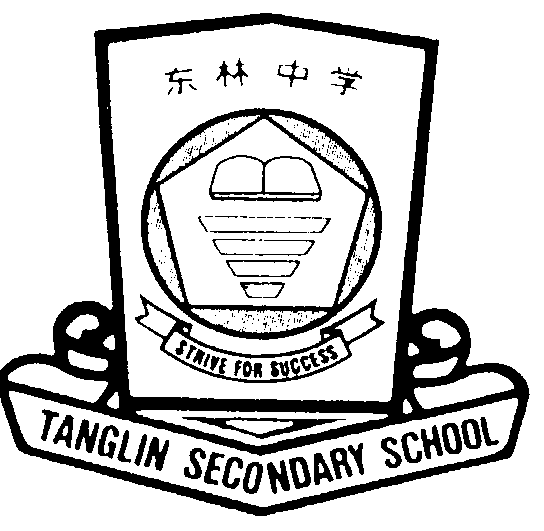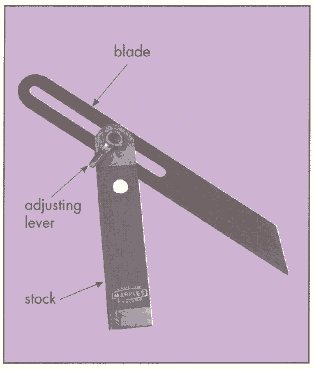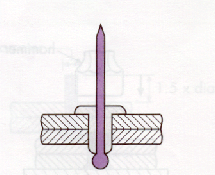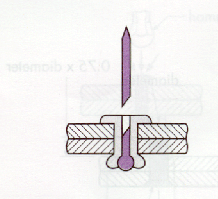

 |
 |
|
MID-YEAR EXAMINATION 1999 SECONDARY TWO EXPRESS DESIGN AND TECHNOLOGY
|
| Name : | Time : 1hour 30 minutes | |
| Class : | Marks : /100 |
|
INSTRUCTIONS TO CANDIDATES This paper consists of three sections. You should write your answers to Questions 1 to 7 in the spaces provided. Question 8(a) should be done in the isometric grid paper and Question 8(b) in the square grid paper. You are advised to spend not more than 20 minutes on Section A 20 minutes on Section B 50 minutes on Section C. This paper consists of 8 printed pages. |
|
|
Section A (30 marks) You are advised to spend not more than 20 minutes on this part. Attempt all questions. 1. Name the following tools and state their uses: |
 |
Name of tool : folding bar (1) Use of tool: making a 90 degrees bend on sheet metal (1) |
|
 |
Name of tool : rasp (1) Use of tool: shaping wood (1) |
|
 |
Name of tool : sliding bevel (1) Use of tool: check the angle between two flat surfaces of a piece of wood. (1) |
|
 |
Name of tool : hole saws (1) Use of tool: to make big holes in acrylic (1) |
|
2. Fill in the blanks with suitable words. a. Metals can combine with other metals or elements to form alloys. (1) b. Stainless steel is used for making cutlery and kitchen utensils because the material is non toxic. (1) c. The main reason for using phenolic to make electric fittings is because it is a good insulator against heat and electricity. (1) d. GRP is very suitable for making outdoor structures such as bus-stop shelter and play ground equipment because it is weather resistant. (1) e. Seasoning is the process of removing excess moisture from freshly-cut timber. (1) f. When zinc is exposed to air, a layer of oxide is formed. This oxide protects the metal from corrosion. (1) 3. Suggest a suitable material for making each of the following products: (6 marks) e.g. raffia polypropylene a. telephone casing urea formaldehyde (1) b. HDB letter boxes duralumin (1) c. musical instruments bronze (1) d. plaques pewter (1) e. twist drills high speed steel (1) f. fishing weights lead (1) 4. Answer the following questions in complete sentences. a. Explain why templates are sometimes used in marking out. (2) Templates are used to help mark out the desired shape quickly and accurately on a workpiece. b. What tools are used to cut large holes in wood? (Name the cutting tools and the tool that is used to hold the cutting tools). What is this process called? (4) A ratchet brace is used with forstner bits and auger bits to bore holes in wood. c. Name the tool that is used to cut straight and external curved edges of a sheet metal.(1) Straight snips d. Why do you use a mallet and not a hammer to bend sheet metal? (1) To avoid damaging the workpiece. e. Why is it not advisable to buff a small work piece on the buffing machine? (1) It would be difficult to have a firm grip on the work piece. f. Explain why it is sometimes necessary to heat up a metal workpiece before bending is carried out. (1) To soften the metal so that it is easier to bend.
Section B (20 marks) You are advised to spend not more than 20 minutes on this part. Attempt all questions. Answer the following questions in complete sentences 5. Describe how you would make an acrylic fluted dish by filling in the blanks under the four steps given below: Step 1 : Marking out - Describe how you would mark out on the acrylic.Name the tools used. (2) Use a pair of compasses to mark out the circle on the acrylic protective sheet. Step 2 : Cutting and Shaping - Describe how you would cut and shape the acrylic. Name the tools used. (3) Use a coping saw to cut out the outline of the circle. Use a half round file to file the circle. Step 3 : Finishing - Describe how you would finish.Name the tools and equipment used. (3) Use a smooth file to smooth the circle. Use an abrasive paper with water to sand the acrcylic. Then use the buffing machine to buff with wax. Step 4 : Thermoforming - Describe how you would thermoform and shape the acrylic. Wear a pair of gloves and place the acrylic into the oven. When the plastic is pliable, remove it from the oven and place it on the former. With the former, form it into the required shape.
6. The steps in joining two metal parts are shown below. Fill in the blanks to describe how the two metal parts are joined together. (10) |
 |
 |
|
| 1.Drill a hole through both pieces of metal. | 3.Use pop riveting pliers to pull out the pin. | |
 |
 |
|
| 2. Place a pop rivet into the hole. | 4.Riveted joint. |
|
Section C (50 marks) 7. You have been asked to design a small wooden first-aid box. a. State two factors you would consider when designing the first-aid box. (2) Any two : safety, appearance, materials and cost. b. What type of wood would you use to make the first-aid box? (2) Pine c. Give one reason for your choice of wood. (2) Easy to work with. d. Suggest two types of joints you would use to assemble the parts. (4) finger joint for the carase and through housing joint for the shelf. (similar answers will also be accepted). e. In the space provided, sketch a 3-dimensional view of the first-aid box. (5) Show clearly the joints that you have chosen.
8. The figure shows a geometrical solid. a. Draw an isometric view of the solid on the isometric grid paper. (15 ) b. On the square grid paper, draw the Front Elevation, End Elevation and Plan of the solid as viewed from the direction of the arrows. (20) All dimensions are in millimetres. Do not dimension your drawings.
END-OF-PAPER
|